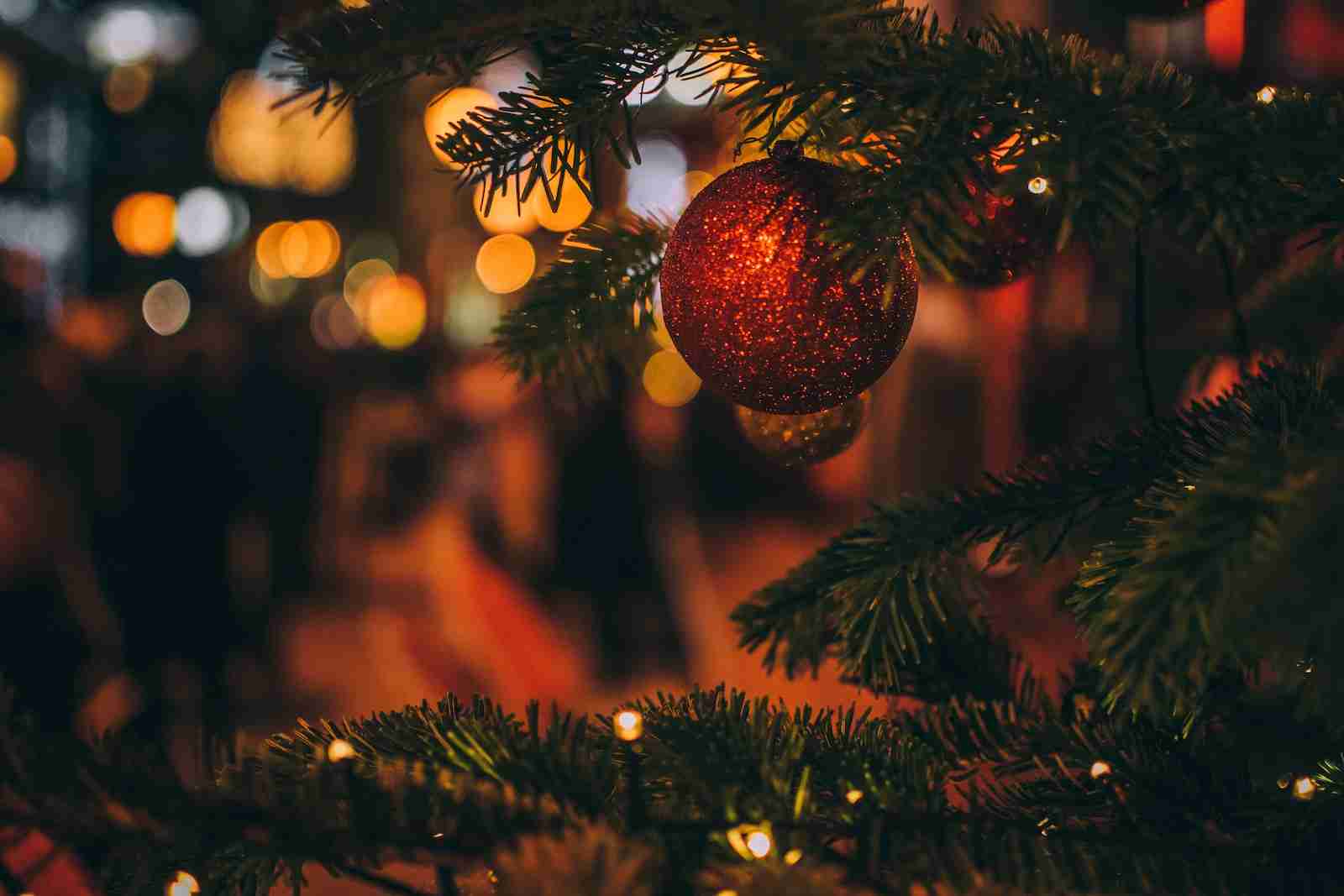24 Interesting Facts About Christmas | Unwrap the Magic
1. The first recorded use of the phrase Merry Christmas was in 1534 in England.
It is the first known instance of its use in print and remains a beloved part of annual holiday traditions to this day. It’s the perfect way to kick off our favourite time of the year—a gesture full of good cheer and open hearts.
Since its earliest use five centuries ago, this special phrase has brought joy and anticipation every December.
2. The traditional colours of Christmas are red, green, and white.
These iconic hues are synonymous with the holiday season: red symbolizes joy, green represents winter, and white reflects peace and goodwill.
These three main colours take centre stage during Christmas in cultures worldwide, adding a festive spirit to what is perhaps one of the most important times of the year.
3. Santa Claus is derived from St. Nicholas, a fourth-century bishop.
Saint Nicholas contributed greatly to different aspects of our modern-day Christmas celebration, including the initial idea for a benevolent figure known as Santa Claus.
The legacy of Santa Claus lives on through his generosity and loving spirit, as he prepared special treats for adolescents in need during the holiday season. And this is why this iconic character is loved by so many worldwide.
4. The original Christmas tree was a fir tree decorated with apples to symbolize the Garden of Eden.

The Christmas Tree we are familiar with stems from a centuries-old German tradition. It all began with a simple fir tree and some decorations made from everyday items.
Apples have long been associated with the Garden of Eden and its forbidden fruit. Eventually, additional festive objects were also added to this traditional presentation.
Long strips of paper were common knowledge during ancient times as a reminder of God’s word as expressed publicly on scrolls.
5. Joel Roberts Poinsett, the American ambassador, introduced the Mexican-native poinsettia as an American Christmas custom in 1825.
The festive plant was an innovative addition to American Christmas customs. As the Ambassador of the United States, Poinsett had become familiar with its symbolism while serving in Mexico.
He saw an opportunity to bring joy to his fellow Americans and graciously introduced the tradition throughout America. One hundred twenty years later, in 1945, this flower finally received its now famous name: the poinsettia.
6. Silent Night is the most popular Christmas carol in the world.
Silent Night is no ordinary holiday song; it’s without question the most revered and popular Christmas carol of all time.
Above all other contemporary and traditional Christmas jingles, its calming melody has stood the test of time, echoing through churches and homes worldwide throughout seemingly unending wintertime celebrations.
7. The candy cane is a traditional symbol of Christmas.
Its signature two-toned twisting shape, usually filled with white and red stripes to evoke a feeling of traditional cheer, has become iconic worldwide.
The legend goes those holiday revellers who hung it on their door or festive tree did so in honour of the wise men’s gifts delivered to Jesus long ago—namely, scent and flavour.
8. In 1889, President Benjamin Harrison started the White House Christmas tree tradition.

The inaugural White House Christmas tree was positioned in the second-floor Oval Room during the Benjamin Harrison administration in 1889.
This historical moment unfolded in what was then a family parlour and library adorned with candles specifically for the delight of Harrison’s grandchildren.
9. The first Christmas card was commissioned in 1843 by Englishman Henry Cole.
He was passionate about spreading goodwill and love during that holiday season, long before mailing out cards was commonplace.
This marked a major milestone in connecting people during a time when communication across geography could be very difficult.
10. Haddon Sundblom’s illustrations in Coca-Cola’s advertising campaign popularised Santa Claus’ red outfit.
The jolly red outfit Santa Claus is known for today got a big boost from Haddon Sundblom’s illustrations. In a Coca-Cola advertising campaign, Sundblom depicted Santa in a vibrant red suit, which quickly caught on as the standard image of Santa.
These ads have had such a lasting impact that Santa’s red attire is now an iconic part of Christmas imagery, recognized and loved by people worldwide during the festive season. It’s a perfect blend of marketing genius and holiday tradition.
11. The original 12 days of Christmas are the twelve days between December 25th and January 6th.
The holiday season is marked by the 12 Days of Christmas, a well-known festivity that begins on December 25th. For twelve days in a row, from the day of Christmas until Epiphany (January 6th), these days become filled with endless celebrations and traditions.
Each day corresponds to a unique custom to honour the holiday season in all its splendour, with festivities culminating in the Twelfth Night.
12. The most popular Christmas movie of all time is It’s a Wonderful Life.
With cosy snowy scenes, heartwarming messages of hope, and a classic comet kite featuring prominently in its pivotal scene, It’s a Wonderful Life has legitimately earned the title of most popular Christmas movie ever.
From etching its place in holiday TV culture to inspiring moments of reflection around the beloved holiday, this 1940s classic film has proven to be an audience favourite across generations.
13. Santa Claus is called Father Christmas or Papa Noel in some countries.
In various countries, Santa Claus is called Father Christmas in the United Kingdom and Papa Noel in Hispanic cultures, reflecting diverse cultural influences and linguistic traditions.
These regional variations, rooted in historical folklore and language differences, highlight the rich tapestry of global holiday traditions.
Interestingly, some cultures also refer to this beloved figure as Saint Nicholas or simply Santa. Regardless of the name, he can always expect a warm welcome wherever he stops during the festive season.
14. The phrase Jingle Bells was originally written for Thanksgiving but quickly became a Christmas favorite.
The song Jingle Bells is now ingrained in our concept of Christmas, a season of merriment and cheer. However, the festive tune wasn’t always sung during December.
Originally, it was written for Thanksgiving, but over time, it shifted to become an undisputed holiday classic. Its familiarity during Christmas created a wealth of lasting nostalgia and joy that connected us with generations of families past and present.
15. The first electric Christmas tree lights were invented in 1882 by Edward H. Johnson.
Johnson ushered in a fresh wave of innovation that gave families everywhere lasting holiday lustre.
He pioneered illuminating needles with tiny glass bulbs to bring festive sparkles indoors, marking the beginning of shining starry night skies for generations seeking inspiration for joyous gatherings and gifts around their illuminated evergreen light centres.
16. In some countries, the Nativity Scene is re-enacted to celebrate Christmas.

Across the world, many cultures participate in re-enactments of the Nativity Scene during Christmas. This re-enactment helps to visually represent and honour the story of Jesus’ birth for believers who follow this faith.
For many, celebrating Christmas is more meaningful when technology substitutes for tradition, made tangible through intense practices.
17. Douglas fir and Fraser fir are among the most popular Christmas trees in the United States.
Regarding Christmas trees in the United States, the Douglas fir and Fraser fir are the big favourites. These trees are loved for their full, bushy branches and that fresh, piney scent that fills the room.
They’re also known for their sturdy needles, which hang onto those precious ornaments really well. Whether set up in a cosy corner or decked out with lights and tinsel, these trees have become a true symbol of Christmas cheer in homes nationwide.
And here’s a fun fact: they’re not just pretty; they also create a habitat for wildlife before they’re ever harvested.
18. The first artificial Christmas tree was made in Germany during the 19th century.
It’s worth mentioning that a ground-breaking invention marked a turning point for the holiday season and revolutionized the world of artificial trees.
This invention used goose feathers crafted with wings and tail feathers to create a tree that evoked nature’s beauty and excess.
This quickly prompted similar crafts featuring other species, including peacocks and pheasant feathers. These handmade feathered masterpieces later found great popularity in Germany and worldwide.
19. According to tradition, you will find true love if you find a single strand of hay in your Christmas stocking.
It has been a treasured tradition throughout history to refer to this superstition, nurturing hopes of finding true love even before Santa Claus arrived.
Along with leaves from holly plants and dream interpretations from spiders, the beloved tale of single hay strands signalling romance captures the imaginations of many adults and children during each festive season. Year after year, this fairytale promises the luckiest Christmas socks and joyous blessings.
20. The tradition of giving gifts on Christmas Day began with the Three Wise Men bringing gifts to baby Jesus.

More than 2000 years ago, the Three Wise Men made an epic journey to bring gifts to baby Jesus on Christmas Day. Since then, this annual tradition of gift-giving has foreshadowed the spirit of generosity that is often felt across cultures during this holiday.
Today, commemorating these wise men and their selflessness, many families give tokens of appreciation to those they cherish most on December 25th.
21. In some South American countries, children get their presents from the Three Kings instead of Santa Claus.
Christmas celebrations look a little different in some South American countries. Rather than receiving their presents from jolly ol’ Santa Claus on Christmas Eve, the children find them delivered by none other than the Three Kings.
These kings are thought to have come to pay their respects to the baby Jesus, who was born in a manger.
22. In Japan, a popular Christmas treat is fried chicken.
Christmas in Japan is slightly different from what is celebrated in the West. Instead of fruitcake or rum balls, the Japanese have a special holiday treat: fried chicken.
Many Japanese families enjoy this savoury favourite during Christmas while covering their houses with sparkling lights and decorations.
It’s become such a popular tradition over time that several major restaurants have started to run yearly deals on holiday orders of fried chicken.
23. During World War I, a Christmas truce was declared on the Western Front.
On December 25th, soldiers from both sides of the World War I conflict chose to pursue peace instead of war.
They laid down their arms to celebrate Christmas together, and an unofficial truce was declared as enemies exchanging food, gifts, and songs within no man’s land.
This Christmas truce served as a reminder of how war contrasts with our desire for peace and compassion.
24. Wally Schirra and Tom Stafford of the Gemini 6 space mission played Jingle Bells in space.

Astronauts Wally Schirra and Tom Stafford turned a routine Gemini 6 space mission into a festive occasion.
Floating high above Earth, they took out a harmonica and sleigh bells and played Jingle Bells, making history as their jolly melody became the first song to ring out in the vastness of space during the winter season.
This cheerful interlude added a new layer to the storied traditions of Christmas, even in zero gravity.
FAQS
Christmas is one of the most popular celebrations in the world, and its true name is, in fact, Christ’s Mass, a religious celebration of the birth of Jesus.
The 25th of December is celebrated around the world as Christmas. This is because it is traditionally associated with the birth of Jesus Christ, whom many Christians believe to be the son of God.
Christmas dinner time is full of timeless treats. The focus is often on the turkey, accompanied by a delightful stuffing and smooth mashed potatoes covered in savoury gravy and topped off with tangy cranberry sauce. From there, anything goes to other types of poultry, such as duck or geese, scrumptious roast beef, and piquant ham – all are excellent choices to delight your family’s taste buds.
Pomegranates, figs, and dates are among the most popular fruits eaten at Christmas.
Christmas traces its origins to an ancient festival called Saturnalia, which the Romans celebrated to honour their god of agriculture and wealth, Saturn. During this seven-day festival in December, schools were closed, and Roman citizens gathered to exchange gifts and share meals.
The three traditional colours of Christmas are red, green, and gold. Red symbolizes the blood of Jesus and the love and sacrifice he made for humanity, green represents life and rebirth, and gold represents the star’s light that guided the Three Wise Men to the birthplace of Jesus.
Hanging stockings come from Norse mythology, where children would fill boots with treats for Odin’s flying horse, Sleipnir.







